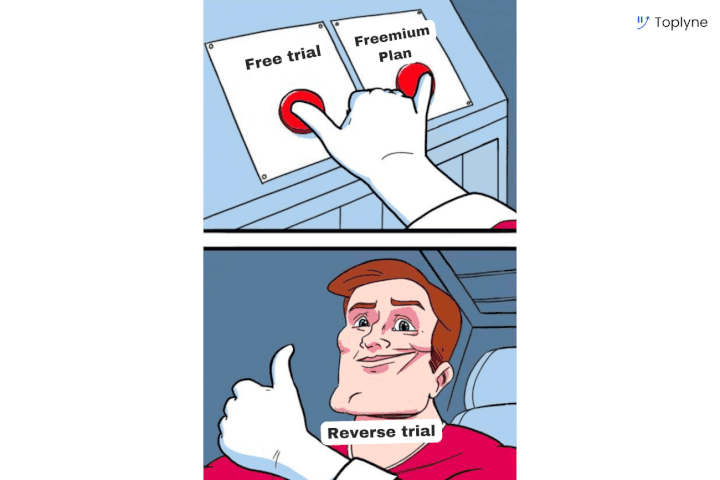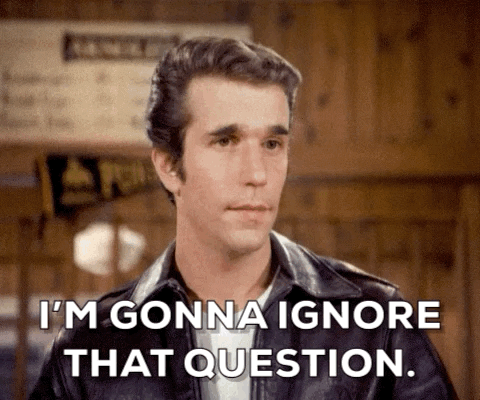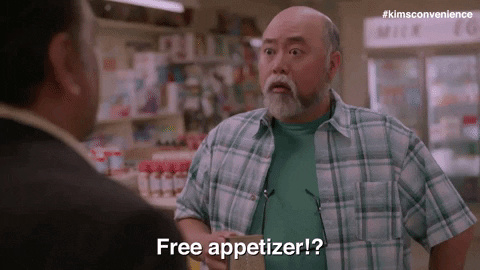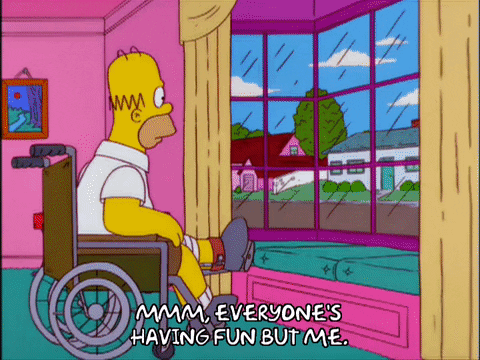What’s a SaaS Reverse Trial? (Definition, Examples, & More!)
What’s a SaaS Reverse Trial? (Definition, Examples, & More!)
What’s a SaaS Reverse Trial? (Definition, Examples, & More!)
Discover what a SaaS reverse trial is, its benefits, when to use it, and examples. Also, learn about a smart tool to help map your reverse trial user journeys.
Discover what a SaaS reverse trial is, its benefits, when to use it, and examples. Also, learn about a smart tool to help map your reverse trial user journeys.
Discover what a SaaS reverse trial is, its benefits, when to use it, and examples. Also, learn about a smart tool to help map your reverse trial user journeys.



What’s it gonna be — a free trial or a freemium plan?
This is one of the most dreaded dilemmas for product-led growth companies.
Unfortunately, there’s no clear answer. *sobs*
So, if you’re thinking…

Don’t!
What if we told you that the decision needn’t be so tough?
Instead, combine the two so you can have your cake and eat it, too. 🍰
Say hello to a ‘Reverse Trial.’
In this article, we’ll first introduce you to SaaS reverse trials and give you reasons why it works for B2C and B2B SaaS businesses. We’ll also give you some excellent examples and best practices to convert your reverse trial users into paying customers.
Ready to get a taste of it?
Let’s go!
What Is a SaaS Reverse Trial?
Simply put — a SaaS reverse trial is a combination of a free trial and a freemium plan.
The reverse trial pricing model puts free users in a timed free trial (usually 14 to 30 days) with access to all paid capabilities. Once the trial ends, they revert to a freemium plan with limited features.
Two simple reasons why this SaaS trial works:
A reverse trial allows free trial users to experience your product’s full potential and get addicted to the juicy paid features early on in their user journeys.
The reverse trial gives users time to engage with the product even after the trial ends and only buy the paid plan when they’re ready.
So does it work for everyone?
Generally, the reverse trial model works well for a SaaS company offering a heavily feature-based product since users get a taste of the paid functionalities without making a commitment. However, there are also cases when it doesn't work.
Although the reverse trial is rare, this business model isn’t brand-new. Companies like Toggl and Calendly are already using this trial conversion model and benefiting from it. (We’ll come to that later)
In fact, product growth managers believe that the reverse trial approach is the “perfect recipe” for driving product-led growth.

Why Should You Consider Implementing the SaaS Reverse Trial Method?
Creating the perfect reverse trial is like balancing a dish 🥧— you use one flavor to offset the other and achieve perfection!
Similarly, in a SaaS reverse trial, you use the perks of both the freemium and the free trial models to avoid the problems that come with each.

What problems exactly?
To understand that, let’s first cover what a free trial and freemium plan are.
Free Trial
Under a free trial, you offer a fully-featured version of your paid SaaS application for a limited time (usually 14 or 30 days). Typically, after the period ends, the free trial user must either pay or lose access to the product.
There are:
Credit card free trials (asks for the user’s credit card details and other confidential information upfront)
No credit card free trials (no confidential information required)
Live demo free trials (a free SaaS tool walkthrough led by a sales team member)
Why does a SaaS company leverage this trial model?
A free trial often results in a higher conversion rate because there’s a sense of urgency to make a payment decision. For SaaS companies, the ideal conversion rate is around 15%.
But...there’s always a but.
Disadvantages of free trials:
Overhead costs: Even when there’s no physical product to dish out, you still incur certain costs when running a free trial (like offering cloud storage). And not all these costs are always compensated by potential customers eventually converting.
Higher churn: While we hope that your free trial users continue using your paid app, there will be some users who just wanna enjoy the freebies and opt out when asked to pay. This can increase your churn rate.
Insufficient time for product adoption: A free trial expects a user to derive value from the SaaS application within the 14 or 30 days trial period. But what takes a startup a day to accomplish might take an enterprise a month, as multiple stakeholders are involved in the decision-making process. In such cases, using time as a value metric doesn't work. It prevents users from sticking around and exploring the app until they reach their aha! moment.
Freemium Plan
In a freemium plan, you offer a new user a limited version of your SaaS product for free indefinitely. The free user will have to upgrade to a paid plan to access premium features or benefits like priority support.
A freemium plan is best suited for growing your user base. Even though the conversion rate is lower than free trials (around 1-10%), almost 25% of the potential users continue using the freemium SaaS app.
In other words, you can get as many people as possible to try your product and earn through indirect monetization, even if they’re only using basic features.
Pretty much like offering free appetizers at a new restaurant. 🤩

After all, we all love free food. 😋
But freemium has its downsides too.
Disadvantages of freemium plans:
A lower conversion rate compared to free trial users.
Potential users might just stick with the “good enough” free plan without experiencing your paid features.
The time, resources, and money needed to manage a large free user base and to convert them into paying users can quickly deplete your cash.
However, the freemium or free trial plans shouldn’t be a trade-off. And that’s where a reverse trial comes in and cancels out the negatives.
Check out how ⬇️
Advantages of a Reverse Trial
Here’s how a reverse trial can help you overcome free trial and freemium limitations:
1. Helps with Conversion + Usage Growth
With a reverse trial, you don’t need to choose between acquisition or conversion goals. You can get the paid conversions of a free trial model with the high product usage that freemium plans deliver.
2. Fosters Long-Term Relationships
A reverse trial gives a new user enough time to experience your product. They get the “try-before-you-buy” paid functionality without harsh time constraints.
And, when the plan downgrades to the freemium version, you continue boosting engagement by giving them space to play around with your product. They can let you know once they’re ready for the conversion talk.

3. Builds Habits Faster
By offering a paid trial first, you shorten the time it takes for a new user to get familiar with and consistently use your product. It allows them to build habits with paid features instead of free ones.
And once they’re downgraded to a freemium plan, they'll miss the taste of those premium features so much — they’ll have to opt for the paid plan eventually!
4. Grow Brand Affinity
Even if your users continue to use the freemium version, you still achieve indirect monetization through those they share your product with.
And the road with these freemium users doesn’t end here. You can always restart the free trial for these users to refamiliarize them with new and existing paid features. And if it clicks for them now, they might convert to a paid user. Cha-ching!💸
But as we mentioned, there are a few cases where a reverse trial might not work.
When Does a Reverse Trial NOT Work?
Before you consider implementing a reverse trial for your SaaS app, ask yourself:
“Is product-led growth (PLG) the right path for you?”
Because PLG isn't always the *soothing soup* 🥣 for all your SaaS troubles. �
A reverse trial may not be the most effective idea when your product has a:
Steep learning curve: If your SaaS tool has complex features that require time to learn to use effectively, it may take longer for users to get to their activation point.
Low usage rate: If your product only has an occasional use case — i.e., users wouldn’t use it on a daily or weekly basis — a reverse trial is probably not the ideal model.
High cost of service: If the cost to serve individual customers is too high — e.g., if your product requires lots of hands-on onboarding or support — then a reverse trial may set you back too much.
So if your business ticks✔️ any of these criteria, you might wanna take reverse trial off the menu.
But if not, let’s take some inspiration from companies that are using reverse trials beautifully.
Two Popular SaaS Reverse Trial Examples
Check out how these two companies successfully implemented a reverse trial model:
1. Toggl ⏲️
Toggl is a time-tracking and project management tool that earlier offered both a free trial and a feature-rich freemium plan. But businesses started misusing the tool by activating its free trial with different email addresses.
To counter this, Toggl switched to a reverse trial. It allows every new user to access the premium features for 30 days and lets them continue using the basic functionalities once the trial is over. Doing so discouraged users from misusing Toggl because when they weren’t completely cut off from the tool, they didn’t bother to create multiple accounts.
As a result, Toggl ended up doubling its revenue from the premium plan.
2. Calendly 📅
Calendly is a popular scheduling app that also uses the reverse trial approach.
They offer a basic “Always Free” plan for individuals to connect one calendar and use the basic scheduling features and integrations.
But if you want to use the tool to its full potential, you can opt for a 14-day trial of its “Teams” plan (no credit card details required).
Once the trial ends, the accounts are automatically downgraded to the free plan.
Since the majority of companies in every industry hold meetings, having a reverse trial has helped Calendly cater to a massive horizontal market. In fact, over 10 million people and 50,000 companies use Calendly worldwide!
If these examples resonate with your SaaS product, and you wish to try the reverse trial model, a few best practices can help you along the way.
Four Best Practices to Turn Reverse Trial Users into Paying Customers
To cook up an irresistible reverse trial, you need four secret ingredients:
1. Offer an Exceptional Onboarding Experience During the Trial
Your onboarding process is the first interaction a new user has with your company. It’s actually the point of conversion in the user journey. So try to make a killer first impression.
How?
Begin by personalizing the onboarding process for each user segment. Use welcome screens to collect customer data upon starting the trial. Then, segment these users into cohorts and offer a relevant onboarding experience for each segment.
This helps boost prospective customers’ engagement with features that address their pain points early on, improving paid conversions and customer success.
2. Provoke FOMO in Free Trial Users
Reach out to free users a few days before their trial ends. Remind them of all the yummy features they’ll miss out on if their account is downgraded.

Also, let them know when their account is downgraded. Use this moment as your last chance to persuade them to become a paid user.
3. Offer Multiple Trials to Reengage Users
You may wonder:
Why offer multiple trials to the same freemium users? Won’t they exploit it?
But here are some reasons why you should give it a try:
Your product might have changed in the past 6 or 12 months. It can make users reconsider the value of your new, exciting features.
Your customer might now have a larger budget or are now in a better position to make purchase decisions.
The competitive landscape might have changed. Potential customers may be looking up alternatives.
Bottomline: Don’t make your B2C or B2B SaaS trials a one-time thing. Let your SaaS trial frequency be driven by customer success, even if that means allowing engagement with your premium offering multiple times.
4. Map Every Customer’s Journey
To implement a successful reverse trial, you need to examine every customer's journey.
How?
You can use your product usage data to understand when a user typically needs more advanced features and how long it takes them to develop stickiness with the paid functionalities.
Once you have such insights, it can be easy to determine the ideal duration for your trials and when your sales team should follow up.
Now, if you plan to do all this manually, the right product usage data will take ages to cook. 🍜
Is there a smarter way to do it?
Indeed there is.
Map Your Reverse Trial User Journey and Optimize It with Toplyne
Mapping a user journey can help you identify when and how a trial user reaches specific milestones in your product. You’ll also gain insight into the steps unhappy users usually take — and maybe prevent them from churning.
Once you know all this, you can better optimize your reverse trial model.
What if a tool did all the analysis for you and helped you manage your free trial pipelines as well?
Enter Toplyne.
Toplyne is a behavioral AI that works like a data engineer in the background to surface a high-intent pipeline of product-qualified leads in your existing sales tool.
By identifying the right leads or prospective customers, this tool also helps you increase your win rate and also improves your NRR metric (net revenue retention) by boosting upselling and cross-sell opportunities.
How?
Toplyne easily integrates with your existing sales stack and lets you use product usage insights from a data warehouse like Amplitude, Mixpanel, etc., to target the right cohorts of free users.
Here’s how companies like Canva and Vercel generate sales pipeline from their self-serve funnel using Toplyne:
Step 1/7: Create monetization playbooks to surface conversion and expansion opportunities (leads most likely to convert to paying customers, and teams most likely to grow into larger teams)

Step 2/7: Choose the right leads to target – users (individual users) or accounts (a group of users with an organization).

Step 3/7: Select the frequency at which you would want leads synced in your GTM apps.

Step 4/7: Define how many leads you want by either the number of leads or your expected win rate, depending on your sales capacity and GTM strategy.

Step 5/7: Build custom segments - Build custom segments based on And/Or logic at the deepest level of sub-properties within your product analytics.

Step 6/7: Validate your GTM strategy - Hold back some users as a control group to test your GTM strategy.

Step 7/7: Sync your product qualified pipeline into your GTM destinations - CRMs, sales & marketing execution tools, and customer engagement platforms.

Toplyne: The Perfect Ingredient to Spice up Your Conversions
The reverse trial pricing model provides a powerful combination of a free trial and a freemium plan that can effectively enhance your product usage and drive more conversions.
And with an intuitive tool like Toplyne on your plate 🍽️, you can make the best use of your reverse trial customer data. This headless sales AI tool can help you spot delicious conversion and expansion opportunities.
But that’s not all.
Toplyne can go a step further by helping you reach out to a wide range of user segments and boost your conversion rate effortlessly.
What are you waiting for?
Sign up for free today and get a taste of Toplyne

What’s it gonna be — a free trial or a freemium plan?
This is one of the most dreaded dilemmas for product-led growth companies.
Unfortunately, there’s no clear answer. *sobs*
So, if you’re thinking…

Don’t!
What if we told you that the decision needn’t be so tough?
Instead, combine the two so you can have your cake and eat it, too. 🍰
Say hello to a ‘Reverse Trial.’
In this article, we’ll first introduce you to SaaS reverse trials and give you reasons why it works for B2C and B2B SaaS businesses. We’ll also give you some excellent examples and best practices to convert your reverse trial users into paying customers.
Ready to get a taste of it?
Let’s go!
What Is a SaaS Reverse Trial?
Simply put — a SaaS reverse trial is a combination of a free trial and a freemium plan.
The reverse trial pricing model puts free users in a timed free trial (usually 14 to 30 days) with access to all paid capabilities. Once the trial ends, they revert to a freemium plan with limited features.
Two simple reasons why this SaaS trial works:
A reverse trial allows free trial users to experience your product’s full potential and get addicted to the juicy paid features early on in their user journeys.
The reverse trial gives users time to engage with the product even after the trial ends and only buy the paid plan when they’re ready.
So does it work for everyone?
Generally, the reverse trial model works well for a SaaS company offering a heavily feature-based product since users get a taste of the paid functionalities without making a commitment. However, there are also cases when it doesn't work.
Although the reverse trial is rare, this business model isn’t brand-new. Companies like Toggl and Calendly are already using this trial conversion model and benefiting from it. (We’ll come to that later)
In fact, product growth managers believe that the reverse trial approach is the “perfect recipe” for driving product-led growth.

Why Should You Consider Implementing the SaaS Reverse Trial Method?
Creating the perfect reverse trial is like balancing a dish 🥧— you use one flavor to offset the other and achieve perfection!
Similarly, in a SaaS reverse trial, you use the perks of both the freemium and the free trial models to avoid the problems that come with each.

What problems exactly?
To understand that, let’s first cover what a free trial and freemium plan are.
Free Trial
Under a free trial, you offer a fully-featured version of your paid SaaS application for a limited time (usually 14 or 30 days). Typically, after the period ends, the free trial user must either pay or lose access to the product.
There are:
Credit card free trials (asks for the user’s credit card details and other confidential information upfront)
No credit card free trials (no confidential information required)
Live demo free trials (a free SaaS tool walkthrough led by a sales team member)
Why does a SaaS company leverage this trial model?
A free trial often results in a higher conversion rate because there’s a sense of urgency to make a payment decision. For SaaS companies, the ideal conversion rate is around 15%.
But...there’s always a but.
Disadvantages of free trials:
Overhead costs: Even when there’s no physical product to dish out, you still incur certain costs when running a free trial (like offering cloud storage). And not all these costs are always compensated by potential customers eventually converting.
Higher churn: While we hope that your free trial users continue using your paid app, there will be some users who just wanna enjoy the freebies and opt out when asked to pay. This can increase your churn rate.
Insufficient time for product adoption: A free trial expects a user to derive value from the SaaS application within the 14 or 30 days trial period. But what takes a startup a day to accomplish might take an enterprise a month, as multiple stakeholders are involved in the decision-making process. In such cases, using time as a value metric doesn't work. It prevents users from sticking around and exploring the app until they reach their aha! moment.
Freemium Plan
In a freemium plan, you offer a new user a limited version of your SaaS product for free indefinitely. The free user will have to upgrade to a paid plan to access premium features or benefits like priority support.
A freemium plan is best suited for growing your user base. Even though the conversion rate is lower than free trials (around 1-10%), almost 25% of the potential users continue using the freemium SaaS app.
In other words, you can get as many people as possible to try your product and earn through indirect monetization, even if they’re only using basic features.
Pretty much like offering free appetizers at a new restaurant. 🤩

After all, we all love free food. 😋
But freemium has its downsides too.
Disadvantages of freemium plans:
A lower conversion rate compared to free trial users.
Potential users might just stick with the “good enough” free plan without experiencing your paid features.
The time, resources, and money needed to manage a large free user base and to convert them into paying users can quickly deplete your cash.
However, the freemium or free trial plans shouldn’t be a trade-off. And that’s where a reverse trial comes in and cancels out the negatives.
Check out how ⬇️
Advantages of a Reverse Trial
Here’s how a reverse trial can help you overcome free trial and freemium limitations:
1. Helps with Conversion + Usage Growth
With a reverse trial, you don’t need to choose between acquisition or conversion goals. You can get the paid conversions of a free trial model with the high product usage that freemium plans deliver.
2. Fosters Long-Term Relationships
A reverse trial gives a new user enough time to experience your product. They get the “try-before-you-buy” paid functionality without harsh time constraints.
And, when the plan downgrades to the freemium version, you continue boosting engagement by giving them space to play around with your product. They can let you know once they’re ready for the conversion talk.

3. Builds Habits Faster
By offering a paid trial first, you shorten the time it takes for a new user to get familiar with and consistently use your product. It allows them to build habits with paid features instead of free ones.
And once they’re downgraded to a freemium plan, they'll miss the taste of those premium features so much — they’ll have to opt for the paid plan eventually!
4. Grow Brand Affinity
Even if your users continue to use the freemium version, you still achieve indirect monetization through those they share your product with.
And the road with these freemium users doesn’t end here. You can always restart the free trial for these users to refamiliarize them with new and existing paid features. And if it clicks for them now, they might convert to a paid user. Cha-ching!💸
But as we mentioned, there are a few cases where a reverse trial might not work.
When Does a Reverse Trial NOT Work?
Before you consider implementing a reverse trial for your SaaS app, ask yourself:
“Is product-led growth (PLG) the right path for you?”
Because PLG isn't always the *soothing soup* 🥣 for all your SaaS troubles. �
A reverse trial may not be the most effective idea when your product has a:
Steep learning curve: If your SaaS tool has complex features that require time to learn to use effectively, it may take longer for users to get to their activation point.
Low usage rate: If your product only has an occasional use case — i.e., users wouldn’t use it on a daily or weekly basis — a reverse trial is probably not the ideal model.
High cost of service: If the cost to serve individual customers is too high — e.g., if your product requires lots of hands-on onboarding or support — then a reverse trial may set you back too much.
So if your business ticks✔️ any of these criteria, you might wanna take reverse trial off the menu.
But if not, let’s take some inspiration from companies that are using reverse trials beautifully.
Two Popular SaaS Reverse Trial Examples
Check out how these two companies successfully implemented a reverse trial model:
1. Toggl ⏲️
Toggl is a time-tracking and project management tool that earlier offered both a free trial and a feature-rich freemium plan. But businesses started misusing the tool by activating its free trial with different email addresses.
To counter this, Toggl switched to a reverse trial. It allows every new user to access the premium features for 30 days and lets them continue using the basic functionalities once the trial is over. Doing so discouraged users from misusing Toggl because when they weren’t completely cut off from the tool, they didn’t bother to create multiple accounts.
As a result, Toggl ended up doubling its revenue from the premium plan.
2. Calendly 📅
Calendly is a popular scheduling app that also uses the reverse trial approach.
They offer a basic “Always Free” plan for individuals to connect one calendar and use the basic scheduling features and integrations.
But if you want to use the tool to its full potential, you can opt for a 14-day trial of its “Teams” plan (no credit card details required).
Once the trial ends, the accounts are automatically downgraded to the free plan.
Since the majority of companies in every industry hold meetings, having a reverse trial has helped Calendly cater to a massive horizontal market. In fact, over 10 million people and 50,000 companies use Calendly worldwide!
If these examples resonate with your SaaS product, and you wish to try the reverse trial model, a few best practices can help you along the way.
Four Best Practices to Turn Reverse Trial Users into Paying Customers
To cook up an irresistible reverse trial, you need four secret ingredients:
1. Offer an Exceptional Onboarding Experience During the Trial
Your onboarding process is the first interaction a new user has with your company. It’s actually the point of conversion in the user journey. So try to make a killer first impression.
How?
Begin by personalizing the onboarding process for each user segment. Use welcome screens to collect customer data upon starting the trial. Then, segment these users into cohorts and offer a relevant onboarding experience for each segment.
This helps boost prospective customers’ engagement with features that address their pain points early on, improving paid conversions and customer success.
2. Provoke FOMO in Free Trial Users
Reach out to free users a few days before their trial ends. Remind them of all the yummy features they’ll miss out on if their account is downgraded.

Also, let them know when their account is downgraded. Use this moment as your last chance to persuade them to become a paid user.
3. Offer Multiple Trials to Reengage Users
You may wonder:
Why offer multiple trials to the same freemium users? Won’t they exploit it?
But here are some reasons why you should give it a try:
Your product might have changed in the past 6 or 12 months. It can make users reconsider the value of your new, exciting features.
Your customer might now have a larger budget or are now in a better position to make purchase decisions.
The competitive landscape might have changed. Potential customers may be looking up alternatives.
Bottomline: Don’t make your B2C or B2B SaaS trials a one-time thing. Let your SaaS trial frequency be driven by customer success, even if that means allowing engagement with your premium offering multiple times.
4. Map Every Customer’s Journey
To implement a successful reverse trial, you need to examine every customer's journey.
How?
You can use your product usage data to understand when a user typically needs more advanced features and how long it takes them to develop stickiness with the paid functionalities.
Once you have such insights, it can be easy to determine the ideal duration for your trials and when your sales team should follow up.
Now, if you plan to do all this manually, the right product usage data will take ages to cook. 🍜
Is there a smarter way to do it?
Indeed there is.
Map Your Reverse Trial User Journey and Optimize It with Toplyne
Mapping a user journey can help you identify when and how a trial user reaches specific milestones in your product. You’ll also gain insight into the steps unhappy users usually take — and maybe prevent them from churning.
Once you know all this, you can better optimize your reverse trial model.
What if a tool did all the analysis for you and helped you manage your free trial pipelines as well?
Enter Toplyne.
Toplyne is a behavioral AI that works like a data engineer in the background to surface a high-intent pipeline of product-qualified leads in your existing sales tool.
By identifying the right leads or prospective customers, this tool also helps you increase your win rate and also improves your NRR metric (net revenue retention) by boosting upselling and cross-sell opportunities.
How?
Toplyne easily integrates with your existing sales stack and lets you use product usage insights from a data warehouse like Amplitude, Mixpanel, etc., to target the right cohorts of free users.
Here’s how companies like Canva and Vercel generate sales pipeline from their self-serve funnel using Toplyne:
Step 1/7: Create monetization playbooks to surface conversion and expansion opportunities (leads most likely to convert to paying customers, and teams most likely to grow into larger teams)

Step 2/7: Choose the right leads to target – users (individual users) or accounts (a group of users with an organization).

Step 3/7: Select the frequency at which you would want leads synced in your GTM apps.

Step 4/7: Define how many leads you want by either the number of leads or your expected win rate, depending on your sales capacity and GTM strategy.

Step 5/7: Build custom segments - Build custom segments based on And/Or logic at the deepest level of sub-properties within your product analytics.

Step 6/7: Validate your GTM strategy - Hold back some users as a control group to test your GTM strategy.

Step 7/7: Sync your product qualified pipeline into your GTM destinations - CRMs, sales & marketing execution tools, and customer engagement platforms.

Toplyne: The Perfect Ingredient to Spice up Your Conversions
The reverse trial pricing model provides a powerful combination of a free trial and a freemium plan that can effectively enhance your product usage and drive more conversions.
And with an intuitive tool like Toplyne on your plate 🍽️, you can make the best use of your reverse trial customer data. This headless sales AI tool can help you spot delicious conversion and expansion opportunities.
But that’s not all.
Toplyne can go a step further by helping you reach out to a wide range of user segments and boost your conversion rate effortlessly.
What are you waiting for?
Sign up for free today and get a taste of Toplyne

Related Articles




Behavioral Retargeting: A Game-Changer in the Cookieless Era
Unlock the power of behavioral retargeting for the cookieless future! Learn how it personalizes ads & boosts conversions. #behavioralretargeting




All of Toplyne's 40+ Badges in the G2 Spring Reports
Our customers awarded us 40+ badges in G2's Summer Report 2024.




Unlocking the Full Potential of Google PMax Campaigns: Mastering Audience Selection to Double Your ROAS
Copyright © Toplyne Labs PTE Ltd. 2024
Copyright © Toplyne Labs PTE Ltd. 2024
Copyright © Toplyne Labs PTE Ltd. 2024
Copyright © Toplyne Labs PTE Ltd. 2024